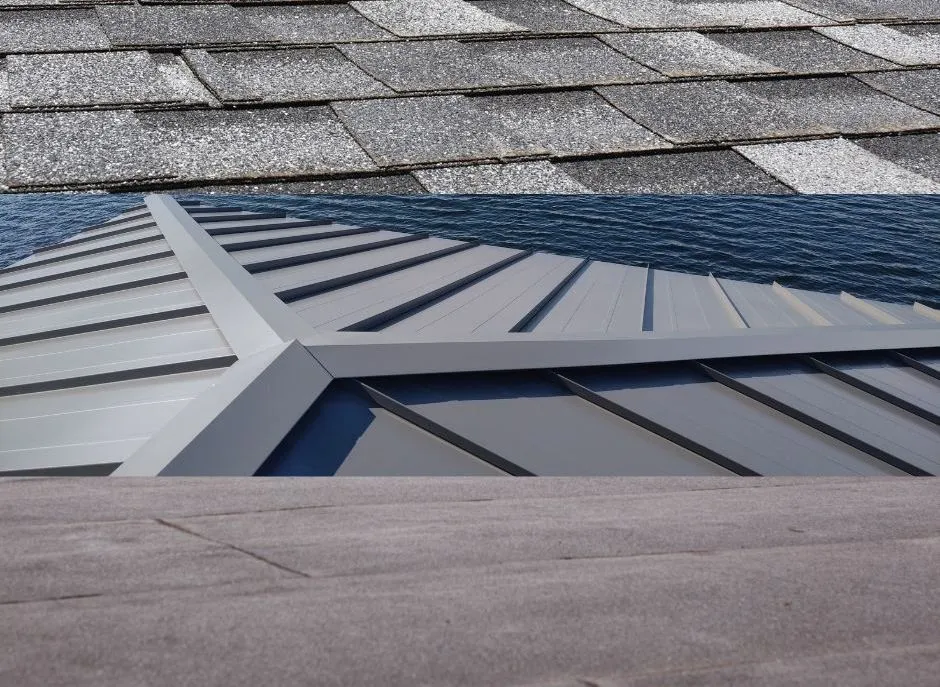Choosing the right material is necessary for a roof that has a longer life, enhances your home’s appeal, gives value, is energy-efficient, and, most importantly, fits your budget. No one wants to deal with constant problems and replacements. Understanding each material’s pros and cons and knowing how they work in different weather conditions will help you choose the suitable roofing material for your home.
1. What are the different kinds of roofing materials?
- Asphalt shingles: They are the more affordable and used roofing material. They are made in many colors, are easy to install and replace, and offer fire protection. Asphalt shingles are available in two categories: architectural shingles, which are stronger and more durable, and three-tab shingles, which are more affordable but made with one single layer.
- Metal: Metals like steel, zinc, copper, and aluminum have a lifespan of 50 to 100 years. It can give you a clean and modern look, prevent ice dams, and provide a fire-resistant roof.
- Slate: Can last as long as 200 years and is resistant to rot, mildew, and insects. However, it can cost you much more than any other materials. It is made from metamorphic rocks, so your house needs to be able to bear its heavy weight.
- Tiles: Roofs made from terracotta, concrete, and slate tiles are made to last for centuries. They offer excellent resistance to wind or roof hail damage, and their system consists of overlapping tiles securely attached to a solid substrate or roof deck.
2. Consider your climate:
Considering your area’s climate is crucial when picking a roofing material. In some cases, your roof covers more square footage than any other part of the structure. While most types of roofing are highly efficient, not all of them are right for all climates. When looking for a new roof, you should consider these materials and their strong suits before making your final decision:
- Asphalt Shingles for humid and cold climates: Heavy-duty varieties are recommended for areas with high humidity levels and cooler weather because they can draw in heat and stand stronger storms and winds.
- Metal roofing for hot and cold climates: It can be more expensive than asphalt shingles, but it allows ice and snow to slide off better than textured materials. It can also work perfectly for hot and humid climates since it resists moisture and reflects heat.
- Wood shingles for cold regions: This material can provide twice the insulating value as asphalt shingles. They can resist water and rain because of their thickness and weight. However, wood is unsuitable for humid areas because constant exposure to moisture can create mold.
- Clay tiles for hot and humid climate: Clay tiles give you a beautiful rustic look and reflect heat and resists the elements as well. They are ideal for absorbing heat during the day and slowly releasing it during the cooler evenings.
- Rubber roof for hot and cold climates: It is efficient, resilient, and affordable. It can be designed to look like other materials like clay, slate, and wood and works well in both hot and cold climates.
3. Your budget:
When selecting a material, your budget is an essential factor to consider and discuss. Every roofing material has different prices for every square foot, and if you are willing you spend more on a higher-end roof material, you will expect a long-term value. Your budget will dictate the material used, and you should take two things into account:
- The project budget: how much money is available to complete the project? A higher budget can mean higher quality and longevity, while a lower budget can mean working with what’s currently affordable.
- The lifetime budget: you need to consider the lifetime cost to maintain the chosen materials. Depending on the roofing material, constant maintenance might be necessary in the form of staining, treating, and repairing.
4. Weight of the material:
A heavy material may affect the structural integrity of your house. Roof systems can vary by weight, from well under a pound per square foot for an aluminum standing seam metal roof, to over 15 pounds per square foot for very thick clay roof tiles. For example, a built-up will typically include the built-up membrane, the layer of gravel for a gravel-surfaced roof, and the insulation and cover board. You should choose a roofing material that compliments the structural component of your building because, as years pass, structures might begin to lose their strength.
For more information and guidance on the ideal material for your roof based on your needs and preferences, contact our friendly professionals at Worthmann Roofing and Gutters by calling our office.

